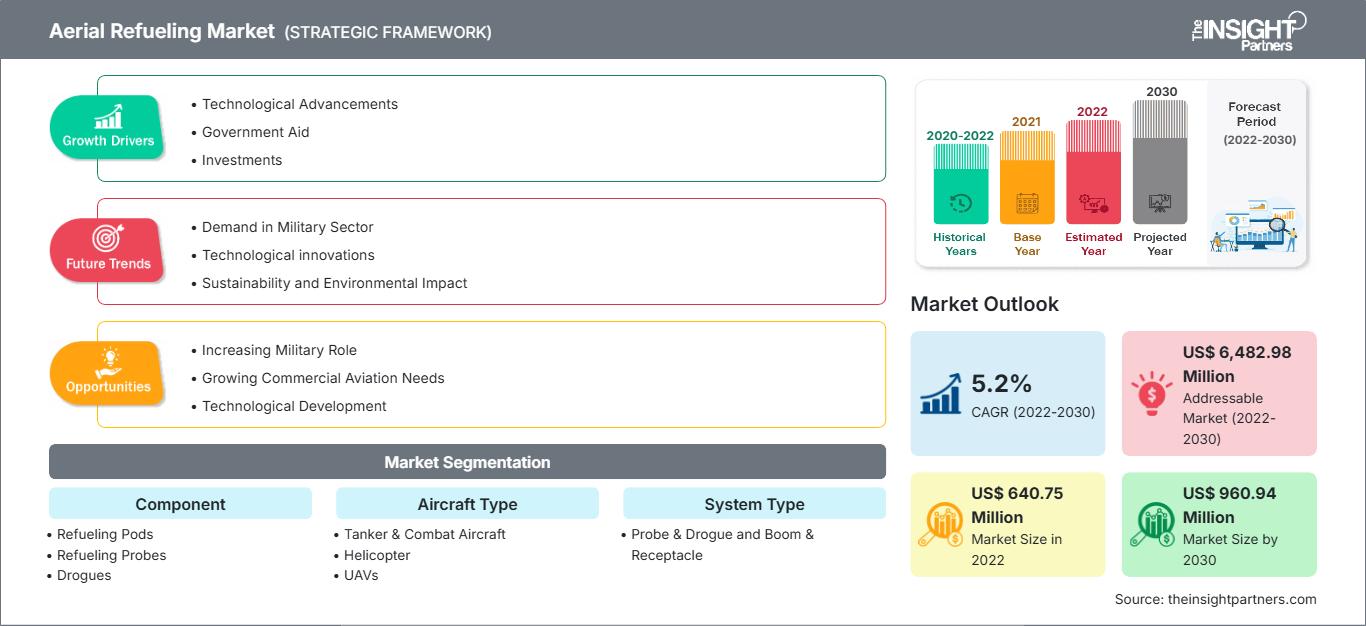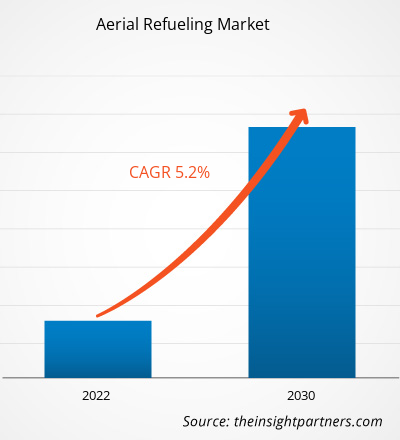[Informe de investigación] El mercado de reabastecimiento aéreo se valoró en US$ 640,75 millones en 2022 y se espera que alcance los US$ 960,94 millones para 2030; se anticipa que registre una CAGR del 5,2% de 2022 a 2030.
Perspectiva del analista:
El pronóstico del mercado de reabastecimiento aéreo se estima a partir de diversos hallazgos de investigación primaria y secundaria, como publicaciones de empresas clave, datos de asociaciones y bases de datos. Este mercado ha experimentado un enorme crecimiento en los últimos años. Uno de los principales factores que impulsa el mercado es el aumento de la flota mundial de aeronaves militares y la sustitución o renovación de las flotas de aviones cisterna militares más antiguas. Otro factor clave es el creciente desarrollo de aviones cisterna de reabastecimiento no tripulados, que actualmente se encuentran en fase de prueba para sus primeras operaciones reales en diferentes fuerzas armadas. Los fabricantes que operan en el mercado se centran principalmente en el desarrollo de productos innovadores para mantenerse competitivos. Sin embargo, algunos de los factores que frenan el crecimiento del mercado de reabastecimiento aéreo incluyen el aumento de las preocupaciones ambientales derivadas de las operaciones de aeronaves y el aumento de los costos de instalación de los componentes del sistema de reabastecimiento. El informe incluye perspectivas de crecimiento a la luz de las tendencias actuales del mercado de reabastecimiento aéreo y los factores que influyen en su crecimiento.
Descripción general del mercado:
El mercado de reabastecimiento aéreo está moderadamente consolidado, con un número limitado de actores que operan en diferentes regiones. Además, algunos países han impulsado sus inversiones militares para adquirir nuevos modelos de aviones cisterna para reemplazar su flota obsoleta, que requiere grandes recursos financieros para operar con éxito. Asimismo, las constantes tensiones entre países como Rusia-Ucrania, China-Taiwán, Israel-Palestina, EE. UU.-China, India-Pakistán e India-China también están impulsando la adquisición de nuevos modelos de aeronaves militares y aviones cisterna para fortalecer sus respectivas fuerzas armadas. Estas tensiones también se deben a la creciente competencia geopolítica entre los diferentes países por fortalecer sus respectivas fuerzas armadas. Por lo tanto, están adquiriendo tecnologías avanzadas y agregando valor a sus respectivas fuerzas armadas. Estos factores están impulsando el despliegue de aviones cisterna y de combate, lo que genera aún más la necesidad de sistemas de reabastecimiento aéreo en diferentes regiones.
Obtendrá personalización en cualquier informe, sin cargo, incluidas partes de este informe o análisis a nivel de país, paquete de datos de Excel, así como también grandes ofertas y descuentos para empresas emergentes y universidades.
Mercado de reabastecimiento aéreo: Perspectivas estratégicas

- Obtenga las principales tendencias clave del mercado de este informe.Esta muestra GRATUITA incluirá análisis de datos, desde tendencias del mercado hasta estimaciones y pronósticos.
Conductor del mercado:
La creciente adquisición de aeronaves y helicópteros militares genera demanda de sistemas de reabastecimiento aéreo
La creciente demanda de tecnologías avanzadas para neutralizar ataques con misiles, junto con la mejora del proceso de identificación o localización del área objetivo y la vigilancia y detección de posibles amenazas aéreas, está impulsando la aplicación del reabastecimiento aéreo avanzado en aeronaves, jets y helicópteros militares. Los organismos gubernamentales de diferentes países están invirtiendo sustancialmente en la adquisición de aeronaves militares, jets de combate y helicópteros de alta gama para hacer frente a las crecientes amenazas aéreas, lo que también está ampliando el alcance de aplicación del reabastecimiento aéreo y de los aviones cisterna a nivel mundial. Existe un creciente número de contratos y acuerdos para la adquisición de aeronaves y helicópteros de defensa avanzados para combatir el aumento de los ataques aéreos avanzados. A continuación, se mencionan algunas de las principales inversiones, contratos y acuerdos:
- En 2023, Boeing obtuvo un contrato por valor de 12 000 millones de dólares para el suministro de helicópteros de ataque Apache a Polonia. Se espera que Polonia reciba 96 helicópteros de ataque Apache AH-64E.
- En 2022, el gobierno de Estados Unidos y Lockheed Martin finalizaron el contrato para la producción y entrega de 398 F-35 por unos 30 mil millones de dólares.
- En 2022, la Fuerza Aérea India anunció su plan de adquirir 114 aviones de combate, de los cuales se espera que 96 se desarrollen en el país.
- En 2022, Suiza firmó un acuerdo para adquirir tres docenas de aviones de combate F-35A.
- En 2022, L3Harris Technologies Inc. consiguió un contrato por valor de 3.000 millones de dólares para suministrar aviones militares al Comando de Operaciones Especiales de Estados Unidos.
Así, la creciente adquisición de aviones y helicópteros militares para combatir los crecientes casos de ataques aéreos impulsa el mercado de reabastecimiento aéreo.
Análisis segmentario:
Según sus componentes, el mercado se segmenta en cápsulas de reabastecimiento, sondas de reabastecimiento, drogues, mangueras, pértigas y otros. En 2022, el segmento de pértigas dominó la cuota de mercado del reabastecimiento aéreo y se espera que mantenga su dominio durante el período de pronóstico. Además, se prevé que las mangueras y las cápsulas de reabastecimiento registren una tasa de crecimiento anual compuesta (TCAC) saludable entre 2022 y 2030. Los principales factores que impulsan el crecimiento del segmento de pértigas son su mayor precio, la integración tecnológica y la facilidad de reabastecimiento durante cualquier vuelo. Sin embargo, es probable que el segmento de pértigas registre un crecimiento lento durante el período de pronóstico debido a la mayor demanda de sistemas de sonda y drogue en las diferentes regiones. La demanda de sistemas de sonda y drogue está aumentando debido a sus precios razonables, flexibilidad, facilidad de instalación y otros parámetros. Es probable que estos factores impulsen el tamaño del mercado del reabastecimiento aéreo durante el período de pronóstico.
Análisis regional:
En términos de ingresos, Norteamérica dominó la cuota de mercado de reabastecimiento aéreo en 2022, y se espera que mantenga su dominio durante el período de pronóstico. El mercado de reabastecimiento aéreo de Norteamérica se valoró en 275,01 millones de dólares en 2022 y se proyecta que alcance los 413,21 millones de dólares para 2030; se espera que registre una CAGR del 5,2% entre 2022 y 2030. Norteamérica alberga a algunos de los principales fabricantes de equipos originales (OEM) de aeronaves, como Boeing, Bombardier, Lockheed Martin y Airbus, que tienen sus respectivas instalaciones de producción en diferentes partes de la región y siguen generando nueva demanda de sistemas de reabastecimiento aéreo desde sus respectivas instalaciones. Estos factores han impulsado la demanda de productos de reabastecimiento aéreo en toda la región. Además, otro factor importante que cataliza el crecimiento del mercado de reabastecimiento aéreo de Norteamérica incluye la presencia de fabricantes de sistemas de reabastecimiento aéreo en países como Estados Unidos y Canadá. Entre estas empresas se incluyen proveedores como Eaton, GE Aviation, Marshall Aerospace & Defense Group, Parker Hannifin Corporation, Boeing y Raytheon Technologies Corporation.
Perspectivas regionales del mercado de reabastecimiento aéreo
Los analistas de The Insight Partners han explicado detalladamente las tendencias regionales y los factores que influyen en el mercado de reabastecimiento aéreo durante el período de pronóstico. Esta sección también analiza los segmentos y la geografía del mercado de reabastecimiento aéreo en América del Norte, Europa, Asia Pacífico, Oriente Medio y África, y América del Sur y Central.
Alcance del informe del mercado de reabastecimiento aéreo
| Atributo del informe | Detalles |
|---|---|
| Tamaño del mercado en 2022 | US$ 640,75 millones |
| Tamaño del mercado en 2030 | US$ 960,94 millones |
| CAGR global (2022-2030) | 5,2% |
| Datos históricos | 2020-2022 |
| Período de pronóstico | 2022-2030 |
| Segmentos cubiertos | Por componente
|
| Regiones y países cubiertos | América del norte
|
| Líderes del mercado y perfiles de empresas clave |
|
Densidad de actores del mercado de reabastecimiento aéreo: comprensión de su impacto en la dinámica empresarial
El mercado del reabastecimiento aéreo está creciendo rápidamente, impulsado por la creciente demanda del usuario final debido a factores como la evolución de las preferencias de los consumidores, los avances tecnológicos y un mayor conocimiento de los beneficios del producto. A medida que aumenta la demanda, las empresas amplían su oferta, innovan para satisfacer las necesidades de los consumidores y aprovechan las tendencias emergentes, lo que impulsa aún más el crecimiento del mercado.

- Obtenga una descripción general de los principales actores clave del mercado de reabastecimiento aéreo
Análisis de los jugadores clave:
El análisis del mercado de reabastecimiento aéreo se realiza mediante la identificación y evaluación de los actores clave del mercado en diferentes regiones. L3Harris Technologies Inc., Raytheon Technologies Corporation, Curtiss-Wright Corporation, Honeywell International Inc., General Electric Company, Safran SA, BAE Systems Plc, Moog Inc., Meggitt Plc y Garmin Ltd. se encuentran entre los actores destacados del informe. Además, Cobham Plc, Safran, Eaton, GE Aviation y Marshall Aerospace & Defense Group se consideran entre los principales actores del mercado gracias a su diversificada cartera de productos.
Desarrollos recientes:
El informe del mercado de reabastecimiento aéreo incluye el posicionamiento y la concentración de las empresas para evaluar el rendimiento de sus competidores. Las estrategias inorgánicas y orgánicas, como el lanzamiento de productos, las fusiones y las adquisiciones, son ampliamente adoptadas por las empresas del mercado. A continuación, se mencionan algunos ejemplos:
- En febrero de 2021, Eaton compró la unidad de sistemas de reabastecimiento aéreo de Cobham Plc en EE. UU. en un acuerdo por un valor de 2.800 millones de dólares.
- En noviembre de 2023, Eaton anunció que había realizado con éxito las pruebas de su prototipo de drogue con estabilización activa de nuevo diseño, centrado principalmente en el reabastecimiento aéreo autónomo para aviones de combate de próxima generación.
Así, estos factores han estado catalizando el crecimiento del mercado de reabastecimiento aéreo desde la perspectiva de los proveedores.
- Análisis histórico (2 años), año base, pronóstico (7 años) con CAGR
- Análisis PEST y FODA
- Tamaño del mercado, valor/volumen: global, regional y nacional
- Industria y panorama competitivo
- Conjunto de datos de Excel
Informes recientes
Testimonios
Razón para comprar
- Toma de decisiones informada
- Comprensión de la dinámica del mercado
- Análisis competitivo
- Información sobre clientes
- Pronósticos del mercado
- Mitigación de riesgos
- Planificación estratégica
- Justificación de la inversión
- Identificación de mercados emergentes
- Mejora de las estrategias de marketing
- Impulso de la eficiencia operativa
- Alineación con las tendencias regulatorias




















 Obtenga una muestra gratuita para - Mercado de reabastecimiento aéreo
Obtenga una muestra gratuita para - Mercado de reabastecimiento aéreo